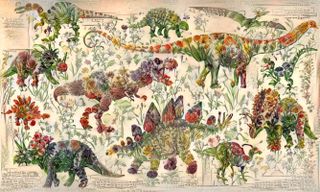Blooming Beasts: Dinosaurs Are Coming Up Roses in AI Artwork

A programmer recently turned to artificial intelligence to create positively charming images of so-called "botanical dinosaurs," representations of tyrannosaurs, stegosaurs, triceratops and others, all constructed entirely out of flowers.
To generate the unusual effect, coder Chris Rodley used a web app that employs a technique known as style transfer, in which an algorithm "learns" a specific visual style and re-creates an image in that style. In this case, the algorithm re-created a selection of dinosaurs in the style of botanical illustrations, using all the visual elements that you'd expect to find in a field guide to local flora — stems, leaves and blossoms in a variety of colors.
Style transfer isn't new, but the unlikely pairing of dinosaurs and flowers was unusual and eye-catching enough to garner quite a bit of attention online. As of yesterday (June 21), Rodley's June 15 tweet sharing the images has gathered over 32,000 likes and about 14,000 retweets. [Super-Intelligent Machines: 7 Robotic Futures]
A team of programmers developed the style-transfer technique and described it in a paper published online in 2015, and the study authors later made style transfer available to the public through the online platform DeepArt, Rodley told Live Science in an email. He used DeepArt to make the dinosaurs, though there are several online platforms offering style transfer as a service for anyone to try, he said.
"Applying a familiar art style to a photo is what most folks do with this. And the results are often incredible. I guess my contribution was experimenting with using it in a somewhat different way," Rodley said.
The idea for the botanical dinosaurs came from an unexpected type of style transfer in an image that Rodley glimpsed on Reddit, he told Live Science. In the image — a reproduction of the painting "Napoleon Crossing the Alps" by Jacques-Louis David — Reddit user vic8760 re-imagined Napoleon and his horse using images lifted from a crowd scene in an unidentified High Renaissance painting, Rodley wrote in a blog post.
"That example doesn't just change the style of the portrait of Napoleon Bonaparte; it actually reconstitutes the image out of different stuff. Of course, from the point of view of the artificial neural network that makes the image, it is just applying the style," he explained.
Sign up for the Live Science daily newsletter now
Get the world’s most fascinating discoveries delivered straight to your inbox.
In the case of Rodley's dinosaur creations, the art style was botanical illustrations, which the algorithm learned first to recognize and then to apply in such a manner that they conformed to the dinosaurs' original body shapes, he said.
"There's lots of trial and error, and a process of negotiation between what you want and what the AI wants — or at least, what its goals are," Rodley told Live Science. "It's the same thing that stonemasons and patchwork quilt-makers and clarinetists all do — an iterative process of using tools to shape raw materials, seeing what happens, then refining or redoing."
As it happens, Rodley's floral dinosaurs have a famous fine-art precedent that dates back to the 16th century — paintings by the Italian artist Giuseppe Arcimboldo, who created human portraits as assemblies of vegetables. A second composite image, which Rodley also tweeted on June 15, mirrored Arcimboldo even more closely, with dinosaurs' bodies created entirely from 19th-century engravings of fruit.
"Oddly enough, I made a Twitter bot (co-created with my sister, Ali Rodley) which also tweets about things made out of other things, like flamingoes made out of skulls," Rodley told Live Science.
"In both cases, machines came up with an idea that for humans is very hard to conceptualize. Because there aren't many pathways in our brains linking flowers and dinos, I guess," he said.
Original article on Live Science.

Mindy Weisberger is an editor at Scholastic and a former Live Science channel editor and senior writer. She has reported on general science, covering climate change, paleontology, biology, and space. Mindy studied film at Columbia University; prior to Live Science she produced, wrote and directed media for the American Museum of Natural History in New York City. Her videos about dinosaurs, astrophysics, biodiversity and evolution appear in museums and science centers worldwide, earning awards such as the CINE Golden Eagle and the Communicator Award of Excellence. Her writing has also appeared in Scientific American, The Washington Post and How It Works Magazine.
Most Popular




